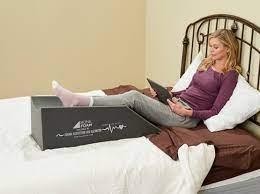A client who is 7 days postpartum calls the provider's office and reports pain, swelling, and redness of her left calf. Besides the client seeing the provider, which of the following interventions should the nurse suggest?
Massage the area.
Apply cold compresses
Flex the knee while resting
Elevate the leg
The Correct Answer is D
Choice A rationale:
Massaging the area is not recommended because the client's symptoms could indicate a possible deep vein thrombosis (DVT), and massaging could dislodge a clot and cause harm.
Choice B rationale:
Applying cold compresses is not recommended if DVT is suspected, as it could potentially worsen the condition.
Choice C rationale:
Flexing the knee while resting is not recommended if DVT is suspected, as it could potentially worsen the condition and increase the risk of a clot traveling to the lungs (pulmonary embolism).
Choice D rationale:
Elevating the leg can help reduce swelling and improve blood flow. However, the client should still see the provider for further evaluation of possible DVT.

Nursing Test Bank
Naxlex Comprehensive Predictor Exams
Related Questions
Correct Answer is B
Explanation
Choice A rationale: Placing the infant in a prone position (lying face down) after feeding is not recommended for a baby with gastroesophageal reflux. The prone position can increase the risk of choking and is not helpful in managing reflux.
Choice B rationale: For an infant with gastroesophageal reflux, placing the baby in an upright position after feeding can help prevent or reduce reflux episodes. Keeping the infant in an upright position allows gravity to assist in keeping stomach contents down and reduces the likelihood of reflux into the esophagus.
Choice C rationale: Placing the infant on the right side after feeding is also not recommended for managing gastroesophageal reflux. The right-side position may not be as effective in preventing reflux as the upright position.
Choice D rationale: Placing the infant on the left side after feeding is not the preferred position for managing gastroesophageal reflux. The left-side position may not be as effective in preventing reflux as the upright position.
Correct Answer is C
Explanation
Choice A rationale: RhoGAM is not given solely based on blood loss. It is administered to prevent Rh isoimmunization, which is unrelated to the amount of blood loss.
Choice B rationale: If the client has previously given birth to an Rh-negative infant, she is already sensitized and would not require RhoGAM for this current ectopic pregnancy.
Choice C rationale: Rho(D) Immune globulin (RhoGAM) is given to Rh-negative individuals to prevent the development of Rh isoimmunization, which could occur if the client is exposed to Rh-positive blood. In the case of an ectopic pregnancy, there may be a possibility of fetal blood mixing with the mother's bloodstream, which could lead to sensitization in an Rh-negative individual.
Choice D rationale: The desire to conceive again does not dictate the need for RhoGAM. It is solely based on the client's Rh factor status and the potential for sensitization during the ectopic pregnancy.
Whether you are a student looking to ace your exams or a practicing nurse seeking to enhance your expertise , our nursing education contents will empower you with the confidence and competence to make a difference in the lives of patients and become a respected leader in the healthcare field.
Visit Naxlex, invest in your future and unlock endless possibilities with our unparalleled nursing education contents today
Report Wrong Answer on the Current Question
Do you disagree with the answer? If yes, what is your expected answer? Explain.
Kindly be descriptive with the issue you are facing.
